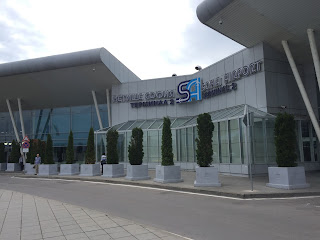Hello, citizens of Earth.
So let's talk traffic. Usually when you think about traffic in the Balkans, you imagine these congested streets full of honking cars from the 70s. Not so much in Sofia. It will sound a bit bias, but I was actually really surprised how Central European the city felt. So let's dive in and take a look at some more useful info about Sofia.
Getting in
Being situated practically in the middle of the Balkans peninsula, Sofia has a great connection to most of the cities and countries nearby. Let's check it out in more details.
The Sofia International Airport is situated about 9 km from the city center. To get there, the easiest way is to take the Red Line of the Sofia Metro (Line 1) which will take you directly to the Terminal 2. There are actually two terminals here - older Terminal 1 operating mostly budget airlines like Wizzair, Ryanair or Easy Jet, while traditional airlines depart from newer Terminal 2. The two terminal building are about 2 km apart so it is walkable, especially if you have only your carry on, but in any cases, you may use the free shuttle going every now and then between both terminals. Its station is right at the exit from the metro. Also, be aware that there is no left luggage at the airport.
If you depart or arrive at night, you only option how to get to and from the airport, may be a taxi, or a pickup setup by your hotel, because the metro stops at midnight and there is no night transportation.
The central bus station is located near the city center (within the walking distance) and connects Sofia with many East and Central European cities (primarily thanks to the carrier Eurolines which operates many long distance bus routes throughout Europe).
Getting around
Public transportation in Sofia is quite reliable and somewhat extended. There are two lines of metro (with the third one currently under construction) which connect the city center with the most prominent suburbs and the Airport). The single ticket costs 1.60 BGN and can be used for one trip including transfers. Just be aware that the validity starts the moment you buy this thing in the machine, or you may end up buying a new one like me. You can also buy a card for 1 BGN where you can upload a credit of 12 BGN which can be used for 10 separate rides which may be useful for some travelers who stay longer in the city.
The metro is supported by an extended network of trams, trolleys and buses. All of them use the same tarif system so one ticket is usable in all forms of transport. Just keep in mind that these tickets are valid for one trip only. It may be interesting to by a 24 hour ticket which costs 4 BGN and is valid for all buses, trams, trolleys and metro.
The city center is quite compact and is really possible to walk through on foot. It may however be challenging sometimes to find a pedestrian crossing. In such cases, just follow the example of the locals and cross the road where the rest do.
Useful info
Bulgaria is a member of the European union, however not of the Schengen area. For EU citizens, it should still generally suffice to travel only with the ID Card. The official currency is Bulgarian Lev (BGN) which is roughly the value of 0,5 EUR. Always check the current exchange rate online beforehand. The official language is Bulgarian (beware the Cyrilic alphabet) and English is not exactly widespread, but especially in the center, you will get by.
The Bulgarians use the standard type C power outlet, flush the toilet paper and drive on the right side of the road.
See you next time and enjoy your trip :)
Lex
Just a regular guy wandering the world, trying to show you it is not as messed up as it appears :)
Subscribe to:
Post Comments (Atom)
Featured Post
Angkor Wat - Angkor What??
Hello there :) You know it was coming to this. The highlight of my trip comes. I think you just simply cannot visit the South Eastern A...

-
Hello, greetings from Lombardy. Today I am bringing you some of the most iconic places you can find in Italy's second largest city, ...
-
Hello guys :) Christmas is approaching and it occured to me that it is time to leave reality behind a little and dive ourselves deep into ...
-
Hi guys, I am back with my newest post. My company sent me on a business trip, so I have spent the last 10 hours on several trains throug...








No comments:
Post a Comment